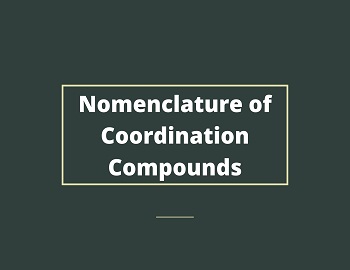Nomenclature of Coordination Compounds:
The nomenclature system recommended by the Inorganic Nomenclature committee of the IUPAC is as follows-
(1) The positive part of a coordination compound is named first and is followed by the negative part. For Example in the complex K2[PtCl6], the name of cation, Potassium is written first followed by the name of Anion [PtCl6]2-.
(2) The names of the ligands are written first followed by the name of the central metal ion and the oxidation number of the metal is expressed by a Roman numeral in Parentheses just after the name of the central metal atom i.e. (Name of Ligands) (Name of Central Metal Atom) (Oxidation Number of Metal in Roman Numeral).
For Example, the complex ion [Co(NH3)6]3+, is named Hexaammine Cobalt (III) ion.
(3) Naming of Ligands- (I) Negative (or anionic) ligands are named by adding ‘O’ to the name of the group. For Example-
| Cl– | Chloro |
| Br– | Bromo |
| CN– | Cyano |
| CH3COO– | Acetato |
| NH2– | Amido |
| OH– | Hydroxo |
| SCN– | Thiocyanato |
| O2H– | Perhydroxo |
| O2- | Oxo |
| O22- | Peroxo |
| SO42- | Sulphato |
| C2O42- | Oxalato |
| NH2- | Imido |
| CO32- | Carbonato |
| NO2– | Nitro |
(II) Positive (or cationic) ligands are named by using the suffix ‘ium’. For Example-
| NO2+ | Nitronium |
| [NH2NH3]+ | Hydrazinium |
| NO+ | Nitrosonium |
(III) Neutral ligands generally have their regular names except that H2O- Aquo, NH3– Ammine, NO- Nitrosyl, CO- Carbonyl. Example- C2H8N2– Ethylene Diamine, C5H5N- Pyridine etc.
(4) Order of Naming Ligands- When different types of ligands are present in the coordination sphere, they are named in the order (I) Negative (II) Neutral (III) Positive ligands in one word (i.e. without separating them by hyphens). For example [Cr(H2O)5Cl]Cl2– Chloropentaaquochromium (III) chloride. However, when several ligands of the same category are present, they are named Alphabetically. For example [Pt(NH3)4NO2Cl]SO4– Chloronitrotetraamine Platinum (IV) Sulphate.
(5) Numerical Prefixes- The prefixes di, tri, tetra, penta, hexa etc. are used to show the number of individual simple ligands. For indicating the number of complex ligands (which already have prefixes di or tri in their names), the prefixes bis (for two), tris, tetrakis, pentakis etc. are used followed by the name of the ligand in Parentheses. For example [Co(en)3]Cl3– Tris (ethylenediamine) cobalt (III) Chloride.
According to the latest IUPAC conventions, the names of the ligands are written in Alphabetical order of preference irrespective of whether they are negative or neutral. Example- [Co(NH3)4Cl(NO2)]- Tetraamminechloronitrocobalt (II).
(6) Ending of Name- In Anionic complexes, the name of the central metal atom ends in ‘ate’, but in neutral or cationic complexes, the name of the central metal atom is retained as that of the element. For Example-
| Ca2[Fe(CN)6] | Calcium hexacyanoferrate (II) |
| K2[Ni(CN)4] | Potassium tetracyanonickelate (II) |
| [Co(NH3)4(NO2)Cl]ClO4 | Tetraamminechloronitrocobalt (III) perchlorate |
| [Fe(H2O)6]SO4 | Hexaaquoiron (II) sulphate |
| [Co(NH3)6]2+ | Hexamminecobalt (II) ion |
| Na3[Co(Ox)3] | Sodium trioxalatocobaltate (III) |
(7) Point of attachment of the Ligand- In case a ligand has two or more donor atoms, its atom attached with the central atom is indicated by the symbol of the element attached after the name of the ligand. For example, SCN– may coordinate through either N or S and the two are distinguished by using the terms thiocyanate-N and thiocyanato-S. Example, (NH4)2[Pt(SCN)6]- Ammonium hexathiocyanato-S-Platinate (IV), [(CH3)4N]2[Co(NCS)4]- Tetramethyl ammonium tetrathiocyanato-N-cobaltate (II).
(8) Naming of Bridging Groups- The ligands binding two metal atoms in Polynuclear complexes containing two or more metal atoms are known as “Bridging Ligands“. Such ligands are named by adding the word ‘μ’ before their names and are separated from the rest of the complex by a hyphen (-). Example-










Comments (No)